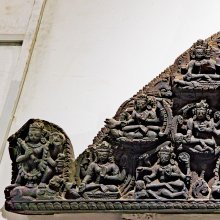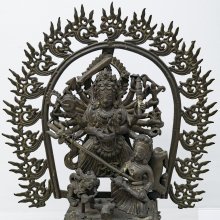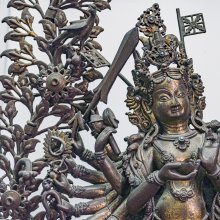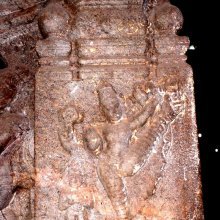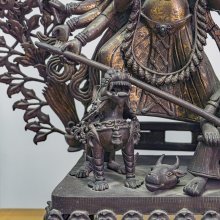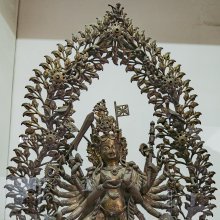Asura, Asūra, Āsura, Asurā: 38 definitions
Introduction:
Asura means something in Buddhism, Pali, Hinduism, Sanskrit, Jainism, Prakrit, the history of ancient India, Marathi, Hindi. If you want to know the exact meaning, history, etymology or English translation of this term then check out the descriptions on this page. Add your comment or reference to a book if you want to contribute to this summary article.
Alternative spellings of this word include Asur.
Images (photo gallery)
(+7 more images available)
In Hinduism
Purana and Itihasa (epic history)
Source: archive.org: Puranic Encyclopedia1) Asura (असुर).—Those born to Kaśyapa of his wife Danu are called Dānavas and those born of his wife Diti are called Daityas. They belong to the demonaic dynasty (Refer under 'Asuravaṃśa' in the genealogy chart). Renowned among the asuras were the following:
Prahlāda, Saṃhlāda, Anuhlāda, Śibi, Bāṣkala, Virocana, Kumbha, Nikumbha, Bali, Bāṇa, Mahākāla, Vipracitti, Śambara, Namuci, Pulomā, Viśruta, Asilomā, Keśī, Durjaya, Ayaśśiras, Aśvaśśiras, Aśva, Śaṅku, Mahābala, Garga, Mūrdhā, Vegavān, Ketumān, Svarbhānu, Aśvapati, Vṛṣaparvā, Ajaka, Aśvagrīva, Sūkṣma, Tuhūṇḍa, Ekapād, Ekacakra, Virūpākṣa, Harāhara, Candra, Kupaṭa, Kapaṭa, Para, Śarabha, Śalabha, Sūrya and Candramas.
2) Asurā (असुरा).—One of the eight daughters born to Kaśyapa of his wife Pradhā. (Śloka 41, Chapter 65, Ādi Parva, Mahābhārata).
Source: archive.org: Shiva Purana - English TranslationAsura (असुर) refers to a group of deities created by Brahmā from the different parts of his body, according to the Śivapurāṇa 2.1.16:—“[...] then, O dear one, Dharma, born out of my conception (saṅkalpa) assumed the form of Manu at my bidding and was engaged in activity by the aspirants (Sādhakas). Then I [viz., Brahmā] created from the different parts of my body innumerable sons, Suras (devas) and Asuras (demons) and many others after assigning them different bodies, O sage”.
Source: Cologne Digital Sanskrit Dictionaries: The Purana Index1a) Asura (असुर).—A deity personified; to be worshipped in housebuildings.*
- * Matsya-purāṇa 253. 26; 268. 16.
1b) 1 —The foes and cognates of Devas;2 born out of the jaghana of Prajāpati; etymology of;3 could secure Hari's blessing by adorning him;4 opposed to yajña;5 the āsura hour;6 praise Śeṣa;7 abode down the earth.8 Ruled the earth for ten yugas when it went back to the Devas on a curse by Śukra after 12 wars;9 worship Barhiṣad Pitrs.10 Had three Indras—Hiraṇyakaśipu, Bali and Praḥlāda;11 lost their refulgence on the eve of vāmana avatāra.12 represent night and darkness and full of tamas.13 Asura's killed in the wars with Devas are born as men in earth and create trouble in this world.14
- 1) Bhāgavata-purāṇa I. 13. 6; VII. 3. 37; XII. 9. 28; Brahmāṇḍa-purāṇa II. 32. 1, 2. 6; Matsya-purāṇa 47. 12; 131. 10, 39-41.
- 2) Bhāgavata-purāṇa VI. 7. 18; Vāyu-purāṇa 31. 11; Brahmāṇḍa-purāṇa II. 8. 5; IV. 9. 67-8.
- 3) Vāyu-purāṇa 9. 4-5; Brahmāṇḍa-purāṇa II. 8. 4; Viṣṇu-purāṇa I. 5. 31.
- 4) Bhāgavata-purāṇa VII. 7. 50.
- 5) Ib. VIII. 1. 17.
- 6) Ib. X. 28. 2.
- 7) Ib. X. 39. 44-45.
- 8) Ib. XI. 24. 13.
- 9) Brahmāṇḍa-purāṇa III. 72. 69-93; Vāyu-purāṇa 97. 68-93.
- 10) Matsya-purāṇa 15. 3.
- 11) Matsya-purāṇa 47. 59.
- 12) Matsya-purāṇa 245. 1.
- 13) Brahmāṇḍa-purāṇa II. 8. 4; Viṣṇu-purāṇa I. 5. 31-4.
- 14) Brahmāṇḍa-purāṇa III. 71. 263.
2) Āsura (आसुर).—A form of marriage.*
- * Viṣṇu-purāṇa III. 10. 24.
Asura (असुर) is a name mentioned in the Mahābhārata (cf. I.59.35, I.65, I.61.9) and represents one of the many proper names used for people and places. Note: The Mahābhārata (mentioning Asura) is a Sanskrit epic poem consisting of 100,000 ślokas (metrical verses) and is over 2000 years old.
Source: valmikiramayan.net: Srimad Valmiki RamayanaAsura (असुर) refers to a “demonic being”.—The Sura and Asura nomenclature is the one that is commonly found in Vedic literature. Sura is a celestial being and Asura is its antonym, usually referred as a demon. Here it is not so because there are many Asuras who made their abode in heaven, like Rahu, Ketu, and others who attain salvation in this mortal life. Even Ravana came from Heaven, and returns there only at the end of the war with Rama. Thus Asuras are not earthly demons but celestial beings of a kind like other demi-gods, namely Yakśa, Gandharva, Kinnara, Kimpuruśa etc.

The Purana (पुराण, purāṇas) refers to Sanskrit literature preserving ancient India’s vast cultural history, including historical legends, religious ceremonies, various arts and sciences. The eighteen mahapuranas total over 400,000 shlokas (metrical couplets) and date to at least several centuries BCE.
Natyashastra (theatrics and dramaturgy)
Source: Wisdom Library: Nāṭya-śāstraAsura (असुर) is the Sanskrit name for a group of deities to be worshipped during raṅgapūjā, according to the Nāṭyaśāstra 3.1-8. Accordingly, the master of the dramatic art who has been initiated for the purpose shall consecrate the playhouse after he has made obeisance (e.g., to Asuras).
Source: archive.org: Natya ShastraAsura (असुर).—Description of a women of demon (asura) type;—A woman who transgresses laws and practices trickery, is confirmed in anger, very cruel, fond of wine and meat, always irascible in temper, very proud, fickle-minded, very covetous, harsh, fond of quarrel, jealous and inconstant in affection, is said to possess the nature of an asura (or, dānava).

Natyashastra (नाट्यशास्त्र, nāṭyaśāstra) refers to both the ancient Indian tradition (shastra) of performing arts, (natya—theatrics, drama, dance, music), as well as the name of a Sanskrit work dealing with these subjects. It also teaches the rules for composing Dramatic plays (nataka), construction and performance of Theater, and Poetic works (kavya).
Vastushastra (architecture)
Source: Wisdom Library: Vāstu-śāstraAsura (असुर, “demons”) refers to one of the three gaṇa (clusters), according to the Mānasāra. Gaṇa is one of the three alternative principles, besides the six āyādiṣaḍvarga, used to constitute the “horoscope” of an architectural or iconographic object. Their application is intended to “verify” the measurements of the architectural and iconographic object against the dictates of astrology that lay out the conditions of auspiciousness.
The particular gaṇa (e.g., asura) of all architectural and iconographic objects (settlement, building, image) must be calculated and ascertained. This process is based on the principle of the remainder. An arithmetical formula to be used in each case is stipulated, which engages one of the basic dimensions of the object (breadth, length, or perimeter/circumference). Of the three gaṇas, the asura (demonic) and manuṣa (human) class are to be avoided.
Source: Brill: Śaivism and the Tantric Traditions (architecture)Asura (असुर) refers to one of the deities to be installed in the ground plan for the construction of houses, according to the Bṛhatkālottara, chapter 112 (the vāstuyāga-paṭala).—The plan for the construction is always in the form of a square. That square is divided into a grid of cells (padas). [...] Once these padas have been laid out, deities [e.g., Asura] are installed in them. In the most common pattern 45 deities are installed.
Asura as a doorway deity is associated with the Nakṣatra called Śata (Śatabhiṣaj) and the consequence is arthakṣaya. [...] The Mayasaṃgraha (verse 5.156-187) describes a design for a 9-by-9-part pura, a residential complex for a community and its lead figure. [...] This record lists a place for a room for visitors at Asura and Śoṣa.

Vastushastra (वास्तुशास्त्र, vāstuśāstra) refers to the ancient Indian science (shastra) of architecture (vastu), dealing with topics such architecture, sculpture, town-building, fort building and various other constructions. Vastu also deals with the philosophy of the architectural relation with the cosmic universe.
Shaktism (Shakta philosophy)
Source: Wisdom Library: ŚāktismAsura (असुर) refers to one of the 53 gods to be worshipped in the western quarter and given pāyasa (rice boiled in milk) according to the Vāstuyāga rite in Śaktism (cf. Śāradātilaka-tantra III-V). The worship of these 53 gods happens after assigning them to one of the 64 compartment while constructing a Balimaṇḍapa. Vāstu is the name of a prodigious demon, who was killed by 53 gods (e.g., Asura).

Shakta (शाक्त, śākta) or Shaktism (śāktism) represents a tradition of Hinduism where the Goddess (Devi) is revered and worshipped. Shakta literature includes a range of scriptures, including various Agamas and Tantras, although its roots may be traced back to the Vedas.
General definition (in Hinduism)
Source: Apam Napat: Indian MythologyThe Asuras are the forces of evil in Indian mythology. They are the sons of the sage Kashyapa and Diti, and consequently the step-brothers of their mortal enemies, the Devas. They are ruled by powerful kings from time to time, and wage perennial war on the Devas. As they are sons of Diti they are also called Daithyas.
Their preceptor is Shukra, who was initially able to secure them the upper hand by bringing back their dead to life with the Mrithasanjivini spell. Later, the Devas also acquired it. There are no clear accounts of why both sides could not use this spell afterwards, but references to this spell are missing from latter texts.
In Buddhism
Theravada (major branch of Buddhism)
Source: Pali Kanon: Pali Proper NamesIn Pali Literature the Asuras are classed among the inferior deities together with the
supannas,
gandhabbas,
yakkhas (DA.i.51),
garulas and
nagas (Mil.117).
Rebirth as an Asura is considered as one of the four unhappy rebirths or evil states (apaya), the others being niraya, tiracchanayoni and pettivisaya (E.g., It.93; J.vi.595; J.v.186; Pv.iv.11).
The fight between the Devas and the Asuras is mentioned even in the oldest books of the Tipitaka and is described in identical words in several passages (E.g., D.ii.285; S.i.222; iv.201ff; v.447; M.i.253; A.iv.432; also S.i.216ff).
A chief or king of the Asuras is often referred to as Asurinda (*), several Asuras being credited with the role of leader, most commonly, however, Vepacitti (E.g., S.i.222; iv.201ff; J.i.205) and Rahu (A.ii.17, 53; iii.243).
(*) Sakka was also called Asurinda and Asuradhipa; see, e.g., J.i.66 (Asurindena pavitthadevanagaram viya) and J.v.245, where we are told that from the time he conquered the Asuras he was called Asuradhipa.
Besides these we find Paharada (A.iv.197, 200) (v.l. Mahabhadda), Sambara (S.i.227), Verocana (S.i.225; probably another name for Rahu, see DA.ii.689), Bali (D.ii.259), Sucitti (D.ii.269) and Namuci (D.ii.269).
The Asuras are spoken of as dwelling in the ocean after having been conquered by Vajira hattha (Indra, elsewhere, (J.v.139) called Asurappamaddana) and are called Vasavas brethren, of wondrous powers and of great glory. They were present at the preaching of the Maha Samaya Sutta (see DA.ii.689). Buddhaghosa says that they were all descendants of an Asura maiden named Sujata. This cannot be the Sujata, Vepacittis daughter, whom Sakka married (J.i.205-6). See also Danava.
There were evidently several classes of Asuras, and two are mentioned in the Pitakas, the Kalakanjakas and the Danaveghasas. The Danaveghasas carried bows in their hands. The Kalakanjakas were of fearsome shape (D.ii.259), and were considered the lowest among the Asuras (D.iii.7; see also Kalankajaka and Vepacitti).
Once the Asuras dwelt in Tavatimsa together with the devas. When Magha Manavaka was born as Sakka, he did not relish the idea of sharing a kingdom with others, and having made the Asuras drunken, he had them hurled by their feet on to the steeps of Sineru. There they tumbled into what came to be known as the Asurabhanava, on the lowest level of Sineru, equal in extent to Tavatimsa. Here grew the Cittapatali tree, and when it blossomed the Asuras knew they were no longer in the deva world.
Wishing to regain their kingdom, they climbed Sineru, like ants going up a pillar. When the alarm was given, Sakka went out to give battle to them in the ocean, but being worsted in the fight, he fled in his Vejayantaratha.
Source: Dhamma Dana: Pali English GlossaryM Specific kind of being. Some of them live in the highest sphere of existence of the apayas (between the one of humans and the one of animals) while others in the set of the world devas. An ordinary human being cannot glimpse an asura.
Source: Pali Kanon: Manual of Buddhist Terms and Doctrines'demons', titans, evil ghosts, inhabiting one of the lower worlds (apāya).
Theravāda is a major branch of Buddhism having the the Pali canon (tipitaka) as their canonical literature, which includes the vinaya-pitaka (monastic rules), the sutta-pitaka (Buddhist sermons) and the abhidhamma-pitaka (philosophy and psychology).
Mahayana (major branch of Buddhism)
Source: Wisdom Library: Maha Prajnaparamita SastraAsura (असुर).—According to the 2nd century Mahāprajñāpāramitāśāstra (chapter XV). Accordingly, “the Asuras are malevolent (duṣṭacitta) by nature and quarrelsome, but they do not break the precepts (śīla) and cultivate merit. They are born in dwellings at the edge of the ocean and also have cities and palaces. The Asura kings are named P’i mo tche to p’o li (Vemacitra asurinda) and Lo heou lo (Rāhu)”.
According to the chapter XLVI, “the power of the Asuras is equal to that of the Devas. Why? Because sometimes they are vanquished by the Devas and sometimes they vanquish the Devas. [...] The Asuras who enjoy the five pleasurable objects (pañcakāmaguṇa) are like the Devas and were disciples of the Buddha as well. [...] Great gods such as the Asuras, Kiṃnaras, Gandharvas, Kumbhāndas, Yakṣas, Rakṣasas, Bhūtas, etc., are Asuras, and when their troops increase, those of the Devas decrease. Their power (anubhāva) and their transformations (nirmāṇa) were exercised at will. The Asura destiny is called thus because the Asuras appear at the head of a list; the others, namely, the Kiṃnaras, Gandharvas, Kuṃbhāṇḍas, Yakṣas, Bhūtas, etc. constitute one and the same destiny with them”.
Source: archive.org: Bulletin of the French School of the Far East (volume 5)Asura (असुर) is the name of a Gandharva appointed as one of the Divine protector deities of Śaya, according to chapter 17 of the Candragarbha: the 55th section of the Mahāsaṃnipāta-sūtra, a large compilation of Sūtras (texts) in Mahāyāna Buddhism partly available in Sanskrit, Tibetan and Chinese.—In the Candragarbhasūtra, the Bhagavat invites all classes of Gods and Deities to protect the Law [dharma?] and the faithful in their respective kingdoms of Jambudvīpa [e.g., the Gandharva Asura in Śaya], resembling the time of the past Buddhas.

Mahayana (महायान, mahāyāna) is a major branch of Buddhism focusing on the path of a Bodhisattva (spiritual aspirants/ enlightened beings). Extant literature is vast and primarely composed in the Sanskrit language. There are many sūtras of which some of the earliest are the various Prajñāpāramitā sūtras.
Tibetan Buddhism (Vajrayana or tantric Buddhism)
Source: Wisdom Library: Tibetan BuddhismAsura (असुर) is the name of a Rāśi (zodiac sign) mentioned as attending the teachings in the 6th century Mañjuśrīmūlakalpa: one of the largest Kriyā Tantras devoted to Mañjuśrī (the Bodhisattva of wisdom) representing an encyclopedia of knowledge primarily concerned with ritualistic elements in Buddhism. The teachings in this text originate from Mañjuśrī and were taught to and by Buddha Śākyamuni in the presence of a large audience (including Asura).

Tibetan Buddhism includes schools such as Nyingma, Kadampa, Kagyu and Gelug. Their primary canon of literature is divided in two broad categories: The Kangyur, which consists of Buddha’s words, and the Tengyur, which includes commentaries from various sources. Esotericism and tantra techniques (vajrayāna) are collected indepently.
General definition (in Buddhism)
Source: Wisdom Library: Dharma-samgrahaAsura (असुर) refers to the last of the “fourteen world protectors” (caturdaśalokapāla) as defined in the Dharma-saṃgraha (section 10). The Dharma-samgraha (Dharmasangraha) is an extensive glossary of Buddhist technical terms in Sanskrit (e.g., caturdaśalokapāla and Asura). The work is attributed to Nagarguna who lived around the 2nd century A.D.
Asura (“demon”) refers to one of the “six destinations” (gata) as defined in the Dharma-saṃgraha (section 57).
Source: Wisdom Library: BuddhismAsura:—Angry demon or demigod. They were a kind of powerful Titan (or giant) who used powerful magic and often fought with the Devas. They appear in every Indian religion. They rejected truth and embraced falsehood.
Source: Buddhist Door: GlossaryAshura in Sanskrit, Asura in Pali. It is a peculiar path in the Six Paths. They are the enemies of the devas, and are the mightest of all demons. In terms of material enjoyment and psychic power, it is similar to Deva. However, in some aspects, it is even worse than the Human Path. The male Asura is extremely ugly and furious, and always fight with each other. The female Asura is as beautiful as an angel. They are proud of themselves, thus reluctant to learn and practice Buddhism.Source: WikiPedia: BuddhismAsura in Buddhism is the name of the lowest ranks of the deities or demigods of the Kamadhatu.
The Buddhist asuras are broadly derived, in general character, from the wicked asuras of Hinduism, but have acquired some very distinctive myths which are only found in Buddhist texts.
In Jainism
General definition (in Jainism)
Source: The University of Sydney: A study of the Twelve ReflectionsAsura (असुर) refers to the “Demons”, according to the 11th century Jñānārṇava, a treatise on Jain Yoga in roughly 2200 Sanskrit verses composed by Śubhacandra.—Accordingly, “Yama’s noose, which cannot be resisted even by the chiefs of gods, demons, men and the lord of snakes (asura—surāsuranarāhīndranāyakaiḥ), in half a moment binds the world of living souls. Yama is clearly the one and only chief conqueror of the three worlds [and] by the mere wish of whom do the 30 gods die”.

Jainism is an Indian religion of Dharma whose doctrine revolves around harmlessness (ahimsa) towards every living being. The two major branches (Digambara and Svetambara) of Jainism stimulate self-control (or, shramana, ‘self-reliance’) and spiritual development through a path of peace for the soul to progess to the ultimate goal.
India history and geography
Source: Academia: Ritual Period: A Comparative Study of Three Newar Buddhist Menarche ManualsAsura (असुर) refers to “anti-gods”, according to the “Vādhā byaṃ ke vidhi”: the name of two manuscripts written by (1) Kathmandu-based priest, Badriratna Bajracharya and (2) Buddharatna Bajracharya from Lalitpur.—Badriratna’s text pays the most attention to the invocations of celestial bodies and other cosmologically grouped agents. The list consists of [e.g., anti-gods (asuras)]. In this list, we particularly find the dark forces that are especially adept at causing problems for women, children and, more specifically, girl children, addressed and harnessed.

The history of India traces the identification of countries, villages, towns and other regions of India, as well as mythology, zoology, royal dynasties, rulers, tribes, local festivities and traditions and regional languages. Ancient India enjoyed religious freedom and encourages the path of Dharma, a concept common to Buddhism, Hinduism, and Jainism.
Languages of India and abroad
Pali-English dictionary
Source: BuddhaSasana: Concise Pali-English Dictionaryasura : (m.) a Titan; an Assirian. || asūra (adj.), cowardly or sluggish (person).
Source: Sutta: The Pali Text Society's Pali-English DictionaryAsura, (Vedic asura in more comprehensive meaning; connected with Av. ahurō Lord, ahurō mazdā°; perhaps to Av. anhuš & Lat. erus master) a fallen angel, a Titan; pl. asurā the Titans, a class of mythological beings. Dhpāla at PvA. 272 & the C. on J. V, 186 define them as kāḷakañjaka-bhedā asurā. The are classed with other similar inferior deities, e.g. with garuḷā, nāgā, yakkhā at Miln. 117; with supaṇṇā, gandhabbā, yakkhā at DA. I, 51. ‹-› The fight between Gods & Titans is also reflected in the oldest books of the Pāli Canon and occurs in identical description at the foll. passages under the title of devâsura-saṅgāma: D. II, 285; S. I, 222 (cp. 216 sq.), IV. 201 sq. , V. 447; M. I, 253; A. IV, 432.—Rebirth as an Asura is considered as one of the four unhappy rebirths or evil fates after death (apāyā; viz. niraya, tiracchāna-yoni, petā or pettivisaya, asurā), e.g. at It. 93; J. V, 186; Pv IV. 111, see also apāya.—Other passages in general: S. I, 216 sq. (fight of Devas & Asuras); IV, 203; A. II, 91; IV, 198 sq. , 206; Sn. 681; Nd1 89, 92, 448; DhA. I, 264 (°kaññā); Sdhp. 366, 436.
— or —
Asūra, (adj.) (a + sura1) — 1. not brave, not valiant, cowardly Sn. 439.—2. uncouth, stupid J. VI, 292 (cp. Kern. Toev. p. 48). (Page 89)

Pali is the language of the Tipiṭaka, which is the sacred canon of Theravāda Buddhism and contains much of the Buddha’s speech. Closeley related to Sanskrit, both languages are used interchangeably between religions.
Marathi-English dictionary
Source: DDSA: The Molesworth Marathi and English Dictionaryasura (असुर).—m (S) An evil spirit or demon.
--- OR ---
āsura (आसुर).—a S Relating to an Asura or demon. 2 eye. fig. Fiery, ferocious, wicked, malevolent: horrible, atrocious, shocking: ugly, hideous, frightful--persons or deeds.
Source: DDSA: The Aryabhusan school dictionary, Marathi-Englishasura (असुर).—m A demon. asurī a Relating to the asura, desperate. f A female evil spirit.
--- OR ---
āsura (आसुर).—a Relating to a demon. Wicked, atrocious; ugly.
Marathi is an Indo-European language having over 70 million native speakers people in (predominantly) Maharashtra India. Marathi, like many other Indo-Aryan languages, evolved from early forms of Prakrit, which itself is a subset of Sanskrit, one of the most ancient languages of the world.
Sanskrit dictionary
Source: DDSA: The practical Sanskrit-English dictionaryAsura (असुर).—a. [asu-ra Uṇ1.42]
1) Living, alive, spiritual.
2) An epithet of the Supreme Spirit or Varuṇa.
3) Incorporeal, super-human, divine.
-raḥ [According to Nir. a suratāḥ sthāneṣu na suṣṭu ratāḥ sthāneṣu capalā ityarthaḥ; or astāḥ pracyāvitā devaiḥ sthānemyaḥ or from asu; asuḥ prāṇaḥ tena tadvanto bhavanti ro matvartha; or sordevānasṛjata tatsurāṇāṃ suratvam, asoḥ asurānasṛjata tadasurāṇāmasuratvam; soḥ = praśastādātmanaḥ pradeśāt]
1) An evil spirit, a demon; the chief of the evil spirits; वृकद्वरसो असुरस्य वीरान् (vṛkadvaraso asurasya vīrān) Ṛgveda 2.3.4. the Rām. thus accounts for the name:-सुराप्रतिग्रहाद्देवाः सुरा इत्य- भिविश्रुताः । अप्रतिग्रहणात्तस्या दैतेयाश्चासुरास्तथा (surāpratigrahāddevāḥ surā itya- bhiviśrutāḥ | apratigrahaṇāttasyā daiteyāścāsurāstathā) || [In the oldest parts of the Ṛgveda the term Asura is used for the Supreme Spirit and in the sense of 'god', 'divine'; it was applied to several of the chief deities such as Indra, Agni, and especially Varuṇa. It afterwards acquired an entirely opposite meaning, and came to signify a demon or an enemy of the gods. The Brāhmaṇas state that Prajāpati created Asuras with the breath (Asu); particularly from the lower breath. The Vāyu P. says that Asuras were first produced as sons from Prajāpati's groin; cf. also Nir. above].
2) A general name for the enemies of gods, Daityas and Dānavas, distinguished from Rākṣasas descended from Pulastya; कानीयसा एव देवा ज्यायसा असुराः (kānīyasā eva devā jyāyasā asurāḥ) Bṛ. Up.1.3. Bhagavadgītā (Bombay) 11.22.
3) A ghost or spectre.
4) The sun (said to be from as to shine).
5) An elephant.
6) An epithet of Rāhu.
7) A cloud.
8) Name of a warrior tribe.
-rā 1 Night.
2) A zodiacal sign.
3) A prostitute.
-rī 1 A female demon, wife of an Asura.
2) Name of the plant Sinapis Racemosa Roxb. (Mar. kāḷī moharī).
--- OR ---
Asūra (असूर).—a. Ved. Devoid of praise or worship; असूरेः सन्ति सूरयः (asūreḥ santi sūrayaḥ) Ṛgveda 8.1.4. (stotrarahita). ind. In the night.
-ram Ved. Absence of a person to extract the Soma juice; a place devoid of praise.
--- OR ---
Āsura (आसुर).—a. (-rī f.) [असुरस्येदं अण् (asurasyedaṃ aṇ) opp. दैव (daiva)]
1) Belonging to Asuras.
2) Belonging to evil spirits; आसुरी माया, आसुरी रात्रिः (āsurī māyā, āsurī rātriḥ) &c.
3) Infernal, demoniacal; आसुरं भावमाश्रितः (āsuraṃ bhāvamāśritaḥ) Bhagavadgītā (Bombay) 7.15 (for a full exposition of what constitutes āsura conduct, see Bhagavadgītā (Bombay) 16.7-24).
4) Not performing sacrifices.
5) Divine, spiritual.
-raḥ 1 A demon [स्वार्थे अण् (svārthe aṇ)].
2) One of the eight forms of marriage, in which the bridegroom purchases the bride from her father or other paternal kinsmen; (see udvāha); आसुरो द्रविणादानात् (āsuro draviṇādānāt) Y.1.61; Manusmṛti 3.31.
3) (pl.) The stars of the southern hemisphere.
4) A prince of the warrior-tribe Asura.
-rī 1 Surgery, curing by cutting by instruments.
2) A female demon, demoness; संभ्रमादासुरीभिः (saṃbhramādāsurībhiḥ) Ve.1.3.
3) Name of a plant Sinapis Ramosa Roxb. (Mar. moharī; rāī)
-ram 1 Blood.
2) Black salt.
Source: Cologne Digital Sanskrit Dictionaries: Shabda-Sagara Sanskrit-English DictionaryAsura (असुर).—mf.
(-raḥ-rā) An Asura or demon: the Asuras are children of Diti by Kasyapa; they are demons of the first order, and in perpetual hostility with the gods. m.
(-raḥ) The sun. f.
(-rā) 1. Night. 2. A zodiacal sign. 3. A prostitude. f. (-rī) 1. Black mustard, (Sinapis ramosa.) 2. The wife of an Asura. E. a neg. and mura a deity; or as to send, to cast, &c. and uran Unadi affix, ṭāp and ṅīp for the fem. or a neg. and surā spirituous liquor, personified as a damsel produced at the churning of the ocean, who was rejected by the demons and received by the gods.
--- OR ---
Āsura (आसुर).—mfn.
(-raḥ-rī-raṃ) Infernal, demoniac, belonging or relating to the Asuras. m.
(-raḥ) 1. An Asur or demon. 2. A form of marriage, in which the bridegroom gives to the bride, her father and paternal kinsmen, as much as he can afford. n.
(-raṃ) Black salt. f. (-rī) 1. A division of medicine, surgery, curing by cutting with instruments, applying the actual cautery, &c. 2. Mustard. E. asura a demon, aṇ aff. and in the fem. ṅīp.
Source: Cologne Digital Sanskrit Dictionaries: Benfey Sanskrit-English DictionaryAsura (असुर).—i. e. 1. as + ura, I. adj. Eternal,
--- OR ---
Āsura (आसुर).—i. e. asura + a, adj., f. rī. 1. Belonging to the Asuras or demons, [Arjunasamāgama] 10, 30. 2. Demon-like, [Bhagavadgītā, (ed. Schlegel.)] 9, 12; wicked, [Daśakumāracarita] in
Asura (असुर).—[adjective] spiritual, divine. [masculine] spirit, [especially] the highest spirit, later a bad spirit, demon [feminine] ī† ([opposed] sura a god).
--- OR ---
Āsura (आसुर).—[feminine] ī belonging to the Asuras, divine or demoniacal.
Source: Cologne Digital Sanskrit Dictionaries: Monier-Williams Sanskrit-English Dictionary1) Asura (असुर):—[from asu] a mfn. (√2. as, [Uṇādi-sūtra]), spiritual, incorporeal, divine, [Ṛg-veda; Atharva-veda; Vājasaneyi-saṃhitā]
2) [v.s. ...] m. a spirit, good spirit, supreme spirit (said of Varuṇa), [Ṛg-veda; Vājasaneyi-saṃhitā]
3) [v.s. ...] the chief of the evil spirits, [Ṛg-veda ii, 30, 4 and vii, 99, 5]
4) [v.s. ...] an evil spirit, demon, ghost, opponent of the gods, [Ṛg-veda viii, 96, 9]
5) [v.s. ...] [x; Atharva-veda] etc. [these Asuras are often regarded as the children of Diti by Kaśyapa See daitya; as such they are demons of the first order in perpetual hostility with the gods, and must not be confounded with the Rākṣasas or imps who animate dead bodies and disturb sacrifices]
6) [v.s. ...] a Name of Rāhu, [Varāha-mihira’s Bṛhat-saṃhitā] etc.
7) [v.s. ...] the sun, [cf. Lexicographers, esp. such as amarasiṃha, halāyudha, hemacandra, etc.]
8) [v.s. ...] a cloud, [Naighaṇṭuka, commented on by Yāska] (cf. [Ṛg-veda v, 83, 6])
9) [v.s. ...] m. [plural] Name of a warrior-tribe, ([gana] parśv-ādi, q.v.)
10) [v.s. ...] m. of a Vedic school
11) Asurā (असुरा):—[from asura > asu] f. night, [cf. Lexicographers, esp. such as amarasiṃha, halāyudha, hemacandra, etc.]
12) [v.s. ...] a zodiacal sign, [cf. Lexicographers, esp. such as amarasiṃha, halāyudha, hemacandra, etc.]
13) Asura (असुर):—[from asu] ([In later Sanskṛt sura has been formed from asura, as sita from asita q.v.])
14) b See asu.
15) Asūra (असूर):—[=a-sūra] n. ‘absence of sunlight’, only
16) Āsura (आसुर):—1. āsura mf(ī)n. ([from] asura), spiritual, divine, [Ṛg-veda; Vājasaneyi-saṃhitā; Atharva-veda]
17) belonging or devoted to evil spirits
18) belonging or relating to the Asuras, [Ṛg-veda; Atharva-veda; Vājasaneyi-saṃhitā; Kātyāyana-śrauta-sūtra; Prabodha-candrodaya; Daśakumāra-carita] etc.
19) infernal, demoniacal
20) m. an Asura or demon, [Atharva-veda; Aitareya-brāhmaṇa; Pāṇini]
21) a form of marriage (in which the bridegroom purchases the bride from her father and paternal kinsmen), [Āśvalāyana-gṛhya-sūtra i, 6, 6; Manu-smṛti iii, 31] (cf. vivāha)
22) m. [plural] the stars of the southern hemisphere, [Sūryasiddhānta] etc.
23) m. a prince of the warrior-tribe Asura, [Pāṇini]
24) n. blood
25) black salt, [cf. Lexicographers, esp. such as amarasiṃha, halāyudha, hemacandra, etc.]
26) 2. āsura mfn. belonging to Āsuri (below).
Source: Cologne Digital Sanskrit Dictionaries: Yates Sanskrit-English Dictionary1) Asura (असुर):—[a-sura] (raḥ) 1. m. A demon; the sun. (rā) f. Night; a prostitute. (rī) Black mustard; wife of a demon or Asur.
2) Āsura (आसुर):—(raḥ) 1. m. An Asur or Demon.
Source: DDSA: Paia-sadda-mahannavo; a comprehensive Prakrit Hindi dictionary (S)Asura (असुर) in the Sanskrit language is related to the Prakrit words: Asura, Āsura.
[Sanskrit to German]
Sanskrit, also spelled संस्कृतम् (saṃskṛtam), is an ancient language of India commonly seen as the grandmother of the Indo-European language family (even English!). Closely allied with Prakrit and Pali, Sanskrit is more exhaustive in both grammar and terms and has the most extensive collection of literature in the world, greatly surpassing its sister-languages Greek and Latin.
Hindi dictionary
Source: DDSA: A practical Hindi-English dictionaryAsura (असुर) [Also spelled asur]:—(nm) a demon.
...
Prakrit-English dictionary
Source: DDSA: Paia-sadda-mahannavo; a comprehensive Prakrit Hindi dictionary1) Asura (असुर) in the Prakrit language is related to the Sanskrit word: Asura.
2) Āsura (आसुर) also relates to the Sanskrit word: Āsura.
Prakrit is an ancient language closely associated with both Pali and Sanskrit. Jain literature is often composed in this language or sub-dialects, such as the Agamas and their commentaries which are written in Ardhamagadhi and Maharashtri Prakrit. The earliest extant texts can be dated to as early as the 4th century BCE although core portions might be older.
Kannada-English dictionary
Source: Alar: Kannada-English corpusAsura (ಅಸುರ):—
1) [noun] an evil spirit; a devil; a demon.
2) [noun] the sun.
3) [noun] the Supreme.
--- OR ---
Āsura (ಆಸುರ):—
1) [adjective] causing horror; terrific; fearful.
2) [adjective] causing loathsomeness.
--- OR ---
Āsura (ಆಸುರ):—
1) [noun] the feeling caused by a disgusting, abhorrent or detestable thing; loathsomeness; abhorrence.
2) [noun] want of interest; non-inclination of the mind.
3) [noun] the force or momentum of a moving object.
4) [noun] excessiveness; abundance; plentifulness.
5) [noun] pride; arrogance; conceit.
6) [noun] one of the of the eight kinds of marriage in the early Indian society, in which the bridegroom’s family paid the dowry to the bride’s family; ಆಸುರಂ ಮಸಗು [asuram masagu] āsuram masagu to be greatly aroused; to be angry very much; ಆಸುರಂ ಮಾಡು [asuram madu] āsuram māḍu to behave in a very rude way.
Kannada is a Dravidian language (as opposed to the Indo-European language family) mainly spoken in the southwestern region of India.
See also (Relevant definitions)
Starts with (+81): Acuracattuvam, Acurakuncaram, Acurakuru, Acuramanam, Acuramantiri, Acurappantikai, Acurar, Acurarratinton, Ashuracane, Ashurathiya, Ashuravas, Ashuraya, Asura Sutta, Asura Vagga, Asura-banda, Asura-kriya, Asura-vijayin, Asurabanda, Asurabhi, Asurabrahma.
Ends with (+159): Abhasura, Abhyasashura, Acchasura, Aghasura, Agrasura, Alamkarasura, Amdhasura, Anantamukhadevasuranetrasura, Andhakasura, Anuttarasura, Arambhashura, Arishtasura, Aryashura, Asahayashura, Atmavatashura, Attasura, Atyasura, Avasura, Badasura, Bajaramahashura.
Full-text (+2951): Asuraraj, Indrari, Kumbhanda, Asuraripu, Asurahva, Raktabija, Asurarakshasa, Asurakshayana, Asurendra, Asurabrahma, Devasura, Asuri, Asuratva, Bhurihan, Cakradrish, Kritantakalasura, Dhundhu, Kalakeya, Vatapi, Keshi.
Relevant text
Search found 243 books and stories containing Asura, Asūra, Āsura, Asurā, A-sura, A-sūra; (plurals include: Asuras, Asūras, Āsuras, Asurās, suras, sūras). You can also click to the full overview containing English textual excerpts. Below are direct links for the most relevant articles:
Shrimad Bhagavad-gita (by Narayana Gosvami)
Verse 16.6 < [Chapter 16 - Daivāsura-sampada-yoga]
Verse 7.15 < [Chapter 7 - Vijñāna-Yoga (Yoga through Realization of Transcendental Knowledge)]
Verse 11.22 < [Chapter 11 - Viśvarūpa-darśana-yoga (beholding the Lord’s Universal Form)]
The Markandeya Purana (by Frederick Eden Pargiter)
Canto LXXXIX - The Devī-Māhātmya: The slaying of Niśumbha
Canto LXXXVII - The Devī-Māhātmya: The slaying of Caṇḍa and Muṇḍa
Rig Veda (translation and commentary) (by H. H. Wilson)
Chaitanya Bhagavata (by Bhumipati Dāsa)
Verse 2.7.6 < [Chapter 7 - The Meeting of Gadādhara and Puṇḍarīka]
Verse 2.13.281 < [Chapter 13 - The Deliverance of Jagāi and Mādhāi]
Verse 3.2.187 < [Chapter 2 - Description of the Lord’s Travel Through Bhuvaneśvara and Other Placesto Jagannātha Purī]
Tiruvaymoli (Thiruvaimozhi): English translation (by S. Satyamurthi Ayyangar)
Pasuram 3.5.2 < [Section 5 - Fifth Tiruvaymoli (Moym mam pum polil)]
Pasuram 7.6.8 < [Section 6 - Sixth Tiruvaymoli (Pa maru muvulakum)]
Pasuram 1.6.3 < [Section 6 - Sixth Tiruvaymoli (Parivatu il icanai)]
Women in the Atharva-veda Samhita (by Pranab Jyoti Kalita)
6. Goddess Āsurī < [Chapter 4 - Female Deities and the Glorification of Women in the Atharvaveda]
31. Some Other Female Deities < [Chapter 4 - Female Deities and the Glorification of Women in the Atharvaveda]
6b. Hymn to Win the Love of a Husband < [Chapter 2 - The Strīkarmāṇi Hymns of the Atharvaveda]
Related products
